

Seeley & Andersen Train Wreck - 1912
by Jim Proehl
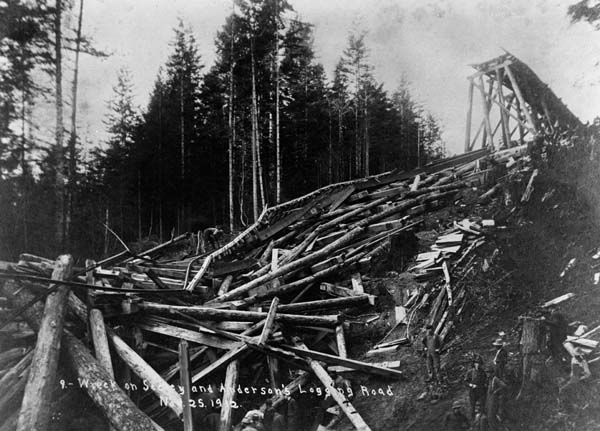
A train wreck in Bandon seems unlikely. Bandon has never had a rail connection with the outside world. However, in the early decades of the 1900s, logging companies punched short-line railroads into the woods to carry logs back to the Coquille River where they could be floated to the mills. A horrific railroad accident made headlines in November of 1912. This headline screamed across the front page of the Coos Bay Times, Wednesday, November 25, 1912.
THREE KILLED AND FOUR HURT NEAR BANDON TODAY LOGGING TRAIN FALLS 70 FEET THROUGH LONG TRESTLE SEVEN HUNDRED POUNDS OF GIANT POWDER AND LOCOMOTIVE EXPLODES
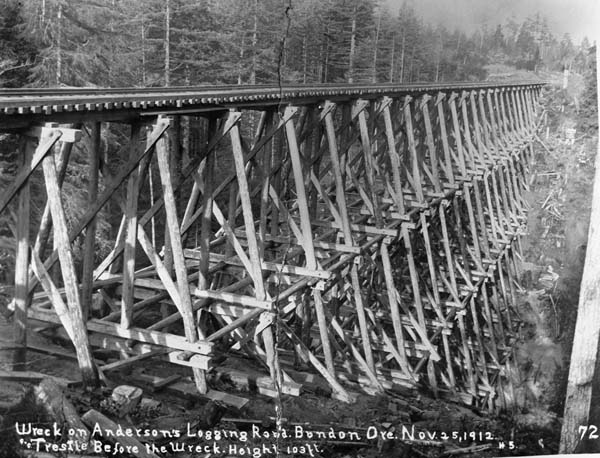
The Times reported: “Three men were killed outright and four badly injured, three probably fatally, this morning when a loaded logging train of the Seeley & Anderson road up Bear Creek, went through the trestle over Fairey (Ferry) Creek, six miles from here (Bandon). The entire train dropped 70 feet into the gulch, the locomotive exploded and about 700 pounds of giant powder on the train also exploded adding to the disaster.
“The wreck occurred about 9 o’clock this morning. It was the first loaded train to cross the big trestle, the logging road being now under construction. The trestle is about 300 feet long and at its highest point is 104 feet above the bed of the creek. Where the train went through, it was 70 feet above the ground.
“The explosion of the big shipment of giant powder was heard in Bandon.
“The explosion of the locomotive and the giant powder, coupled with the impact, reduced the train and logs to splinters. It is one of the most ghastly wrecks, according to parties returning from there, that could be imagined.”
Stories about the Bandon train wreck topped the front page of newspapers for several days. The Coos Bay Times carried this follow-up report November 27.
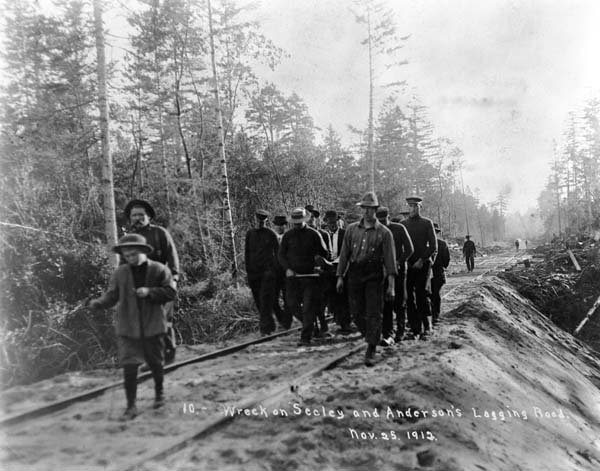
“Fred Atkins, the sixth victim of the wreck on the Seeley and Anderson logging road at the Fairy (Ferry) Creek trestle, died at midnight last night in the Bandon hospital. That he survived as long as he did was remarkable as he was horribly crushed. His skull was fractured, his jaw broken, his arms broken and he was also scalded.
“Rol Anderson, the sole survivor, yesterday gave the first explanation for the cause of the trestle collapsing. He said the brakes had just been set as the train rolled on to the trestle. The brakes held fast and the whole trestle was pushed forward by the train wheels holding fast to the rails with the brakes set. This swung the trestle out of balance and the collapse followed. The appearance substantiates Anderson’s theory. The part of the bridge ahead of the engine ‘buckled’ and the rear portion was torn away.
“Anderson says the last he remembers previous to the accident was when he started to step out on the running board to try and jump clear of the engine.
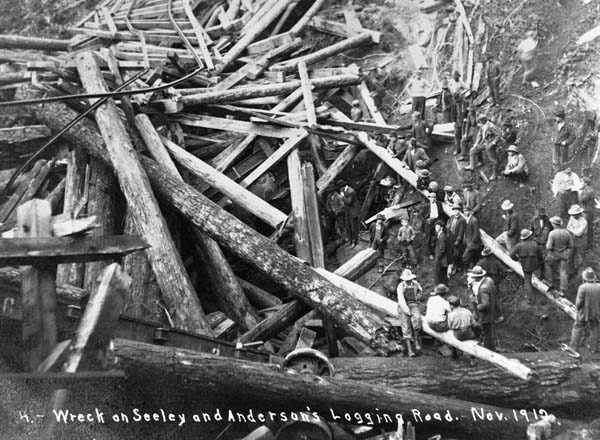
Brakeman Rol Anderson was a brother of the owner of the Seeley and Anderson company.
A graphic account of the wreck was told to the Times by W. F. Harmon, of Marshfield (Coos Bay), who reported that he was supposed to visit the logging camp and would have been on the train if his riverboat from Coquille had not been late. Harmon visited the scene and aided in removing some of the bodies.
In telling of the wreck, Mr. Harmon said: “It occurred about 8 o’clock in the morning. The engine with three loaded cars started down to the dump (log dump at the river.) Seven men were on the train, all riding on the engine.
“Rol Anderson, the brakeman, was the only one of the victims who was able to tell anything about what happened. He was conscious for a time yesterday and he said that soon after they started over the trestle, they felt it sinking. He said he realized what was going to happen and turning to Engineer McDowell said, ‘Good-bye Jim.’ Anderson said that McDowell replied in a husky voice, ‘Keep your seats, boys. We’re gone.’
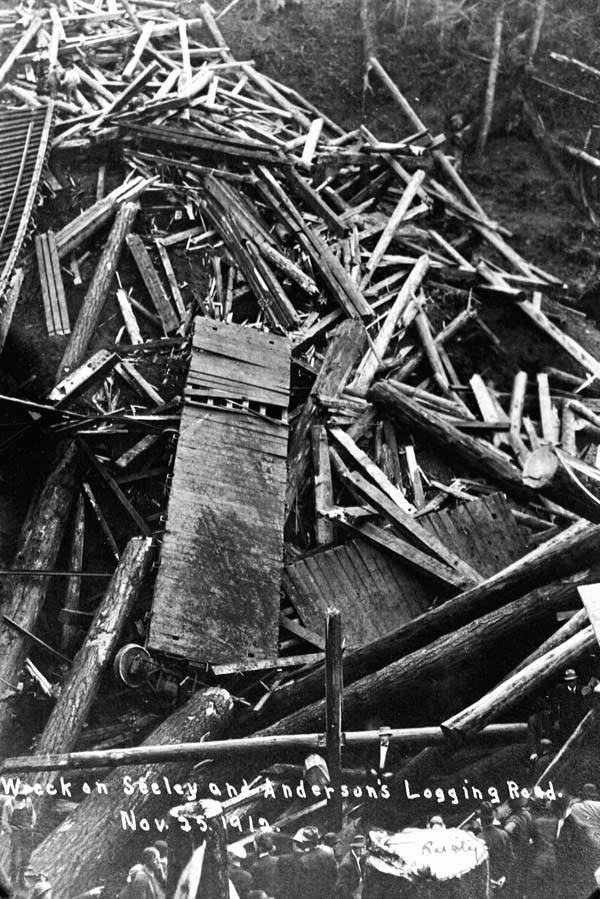
“Anderson said that when he came to, Guy Rose, the timekeeper, was throwing cold water in his face. As soon as he opened his eyes, he heard Rose say, ‘Get up and notify them, you’re not hurt,’ and then Rose fainted. Anderson dragged himself up the embankment and finally succeeded in reaching Radley’s camp, almost three quarters of a mile away, and gave the alarm.
“How Anderson was able to endure the trip is more than one can imagine. He must have suffered awfully.
“All the camps and places shut down and men rushed out and tried to do what they could. The cars, logs, engines and bridge timbers were reduced to a huge pile of broken and twisted iron, splinters and broken wood. The trestle simply collapsed underneath the weight of the train.
“The victims were horribly crushed, bruised and scalded.
“Three were killed outright. They were Engineer Jas. McDowell, Fireman Chas. Smith and a logger named Wright. The latter’s name was first given as Morgan. Smith has a wife and family at the Seeley & Anderson camp and added to the pathos of his death is the fact that his wife is said to be in a very delicate condition, an unborn babe being rendered fatherless.
“Clancy Humphrey was the first of the injured to succumb at the hospital and Guy Rose followed him a few hours later. Rose’s father and brother came down from Myrtle Point yesterday and took the body home.
“Fred Atkins came from California and is reported to have been the champion loader of the coast.
“Stanley Bartlett of the company is entitled to great credit for the strenuous efforts he put forth after the wreck. He worked night and day sending for physicians for the injured, arranging for the care of the victims, notifying their families and doing everything that was possible to be done.
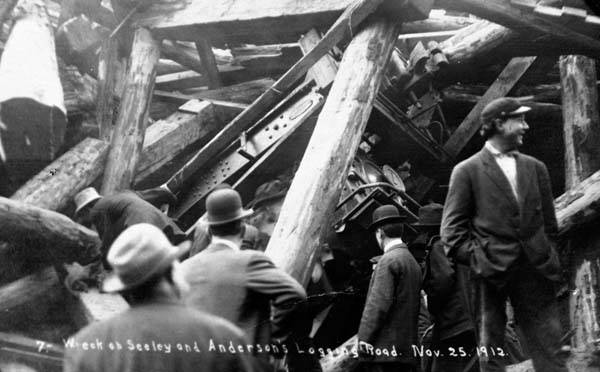
“The report current in Bandon soon after the wreck that a big shipment of giant powder on the wrecked train has exploded, adding to the horror, proved to be unfounded.”
A few pilings in the Coquille River are about the only visible traces of Bandon’s railroading past. The Bandon Historical Society museum has a number of photos of the logging trains that worked the woods. The series of photos documenting the Seeley and Anderson wreck are an arresting part of that collection.